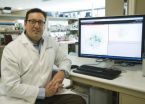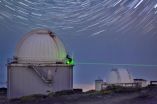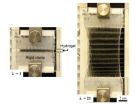Tests for silent neck artery narrowing to curb stroke risk: Waste of resources
Many needless and costly operations required to prevent just 1 stroke
2012-09-06
(Press-News.org) Tests to screen for "silent" neck artery narrowing in a bid to curb the risk of a stroke result in many unnecessary and costly surgical procedures, and ultimately save very few lives, concludes an editorial in the Journal of NeuroInterventional Surgery.
In 2-6% of European men aged 60 plus, the major arteries supplying the brain (carotid arteries) are narrowed by 50-99%. This condition, termed carotid stenosis or atherosclerosis, accounts for 10-15% of strokes (data not in paper).
Carotid atherosclerosis is commonest in those with mild peripheral arterial disease in their legs, a condition known as claudication.
In this group the prevalence of silent carotid atherosclerosis is 15%. As they are already under the care of a vascular specialist, they are considered ideal candidates to test for silent carotid atherosclerosis.
But debate rages as to whether to screen for carotid atherosclerosis to stave off a stroke: the Royal College of Physicians does not currently recommend it, but the US Society for Vascular Surgery strongly backs testing in selected groups.
Those found to have severe (70-99%) carotid narrowing on screening are offered surgical treatment (endarterectomy).
But 133 people with claudication would need to be tested to pick up 20 patients eligible for surgery, and this would only prevent a single stroke, at a cost of around £76, 000, say the authors.
If this policy were to be introduced into England and Wales at age 60 for those with mild peripheral arterial disease, it would cost £17.5 million a year, on the basis that around 669 000 would be eligible for an ultrasound scan, 4600 of whom would then require surgery.
But all this effort would still only prevent 231 strokes, even in this high risk group, equivalent to around 0.2% of all 110,000 strokes sustained in 2010, say the authors.
"The hazards of overdiagnosis have recently been highlighted, and perhaps it is time to realise why it has been recommended that we stop testing for asymptomatic carotid atherosclerosis in the UK," they conclude.
###
END
ELSE PRESS RELEASES FROM THIS DATE:
2012-09-06
Cold Spring Harbor, N.Y. – Most people understand genes to be specific segments of DNA that determine traits or diseases that are inherited. Textbooks suggest that genes are copied ("transcribed") into RNA molecules, which are then used as templates for making protein – the highly diverse set of molecules that act as building blocks and engines of our cells. The truth, it now appears, is not so simple.
As part of a huge collaborative effort called ENCODE (Encyclopedia of DNA Elements), a research team led by Cold Spring Harbor Laboratory (CSHL) Professor Thomas Gingeras, ...
2012-09-06
The locations of millions of DNA 'switches' that dictate how, when, and where in the body different genes turn on and off have been identified by a research team led by the University of Washington in Seattle. Genes make up only 2 percent of the human genome and were easy to spot, but the on/off switches controlling those genes were encrypted within the remaining 98 percent of the genome.
Without these switches, called regulatory DNA, genes are inert. Researchers around the world have been focused on identifying regulatory DNA to understand how the genome works. ...
2012-09-06
Boston, MA – Each year, nearly 2 million people die from tuberculosis – a treatable disease that has been brought under control in the United States, but continues to ravage other parts of the world. This health inequity should prompt a complete rethinking of the way tuberculosis is fought on a global level, argue Salmaan Keshavjee, MD, PhD, and Paul Farmer, MD, PhD, from Brigham and Women's Hospital (BWH). Their argument appears in an essay published September 6 in the New England Journal of Medicine.
"The global approach to fighting tuberculosis has been lacking," ...
2012-09-06
ENCODE, an international research project led by the National Human Genome Research Institute (NHGRI), has produced and analyzed 1649 data sets designed to annotate functional elements of the entire human genome. Data on transcription starting sites (TSS) contributed by a research team at the RIKEN Omics Science Center provided key anchor points linking the epigenetic status of genes observed at the 5' end directly to their RNA output.
The ENCODE (Encyclopedia of DNA Elements) project aims to delineate all functional elements encoded in the human genome. Thirty-two institutes ...
2012-09-06
This press release is available in German.
Physicists at the University of Vienna and the Austrian Academy of Sciences have achieved quantum teleportation over a record distance of 143 km. The experiment is a major step towards satellite-based quantum communication. The results have now been published in "Nature" (Advance Online Publication/AOP).
An international team led by the Austrian physicist Anton Zeilinger has successfully transmitted quantum states between the two Canary Islands of La Palma and Tenerife, over a distance of 143 km. The previous record, set ...
2012-09-06
Cambridge, Mass. - September 5, 2012 - A team of experts in mechanics, materials science, and tissue engineering at Harvard have created an extremely stretchy and tough gel that may pave the way to replacing damaged cartilage in human joints.
Called a hydrogel, because its main ingredient is water, the new material is a hybrid of two weak gels that combine to create something much stronger. Not only can this new gel stretch to 21 times its original length, but it is also exceptionally tough, self-healing, and biocompatible—a valuable collection of attributes that opens ...
2012-09-06
Genome Research publishes online and in print today a special issue dedicated to The ENCODE (ENCyclopedia Of DNA Elements) Project, whose goal is to characterize all functional elements in the human genome. Since the completion of the pilot phase of the project in 2007, covering 1% of the genome, The ENCODE Consortium has fanned out across the genome to study function and regulation on an unprecedented scale. This special issue presents novel findings, methodologies, and resources from ENCODE that bring extensive insight to gene regulation and set the stage for future ...
2012-09-06
(Boston) – Results of a study led by researchers at Boston University School of Medicine (BUSM) and the Veterans Affairs (VA) Boston Healthcare System indicate that the proposed changes to the diagnosis of post-traumatic stress disorder (PTSD) will not substantially affect the number of people who meet criteria for the disorder.
Mark W. Miller, PhD, associate professor at BUSM and a clinical research psychologist at the National Center for PTSD at VA Boston Healthcare System served as lead author of the study, which is published online in Psychological Trauma: Theory, ...
2012-09-06
Windows to the past, stars can unveil the history of our universe, currently estimated to be 14 billion years old. The farther away the star, the older it is — and the oldest stars are the most difficult to detect. Current telescopes can only see galaxies about 700 million years old, and only when the galaxy is unusually large or as the result of a big event like a stellar explosion.
Now, an international team of scientists led by researchers at Tel Aviv University have developed a method for detecting galaxies of stars that formed when the universe was in its infancy, ...
2012-09-06
Scientists have completed a comprehensive map of genetic mutations linked to an aggressive and lethal type of lung cancer.
Among the errors found in small cell lung cancers, the team of scientists, including those at the Johns Hopkins Kimmel Cancer Center, found an alteration in a gene called SOX2 associated with early embryonic development.
"Small cell lung cancers are very aggressive. Most are found late, when the cancer has spread and typical survival is less than a year after diagnosis," says Charles Rudin, M.D., Ph.D., professor of oncology at the Johns Hopkins ...
LAST 30 PRESS RELEASES:
[Press-News.org] Tests for silent neck artery narrowing to curb stroke risk: Waste of resources
Many needless and costly operations required to prevent just 1 stroke



